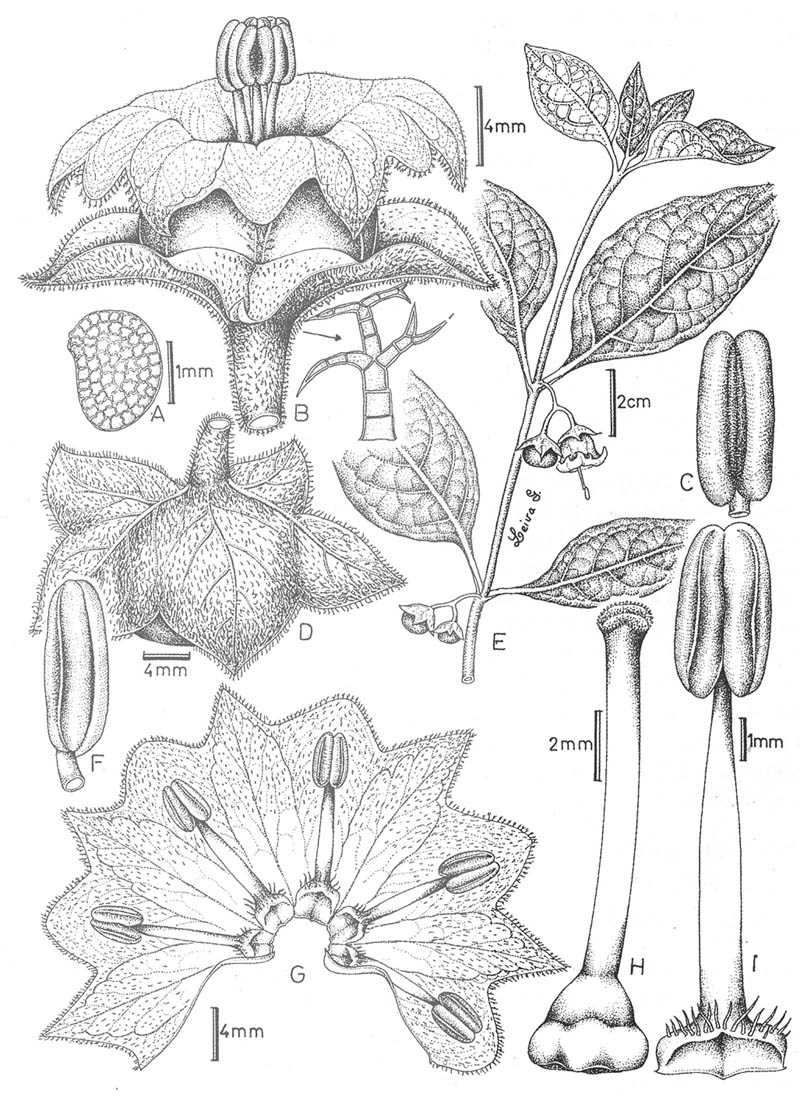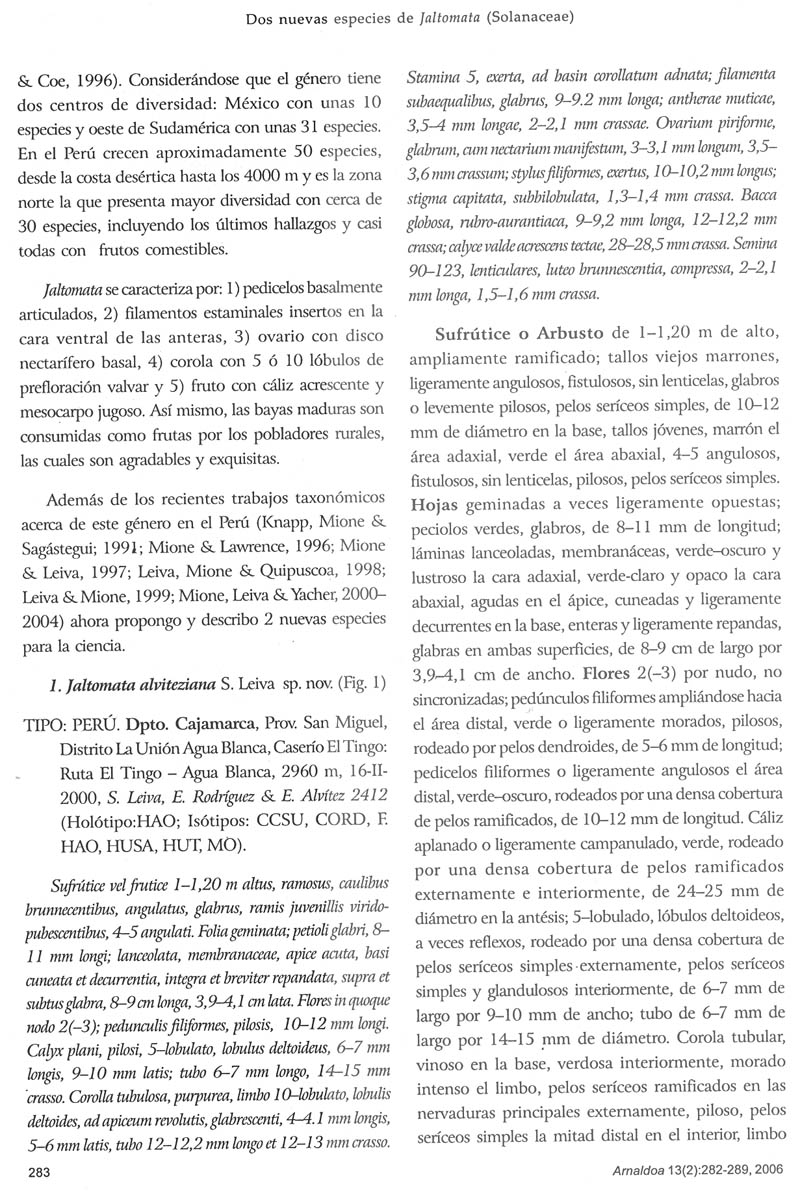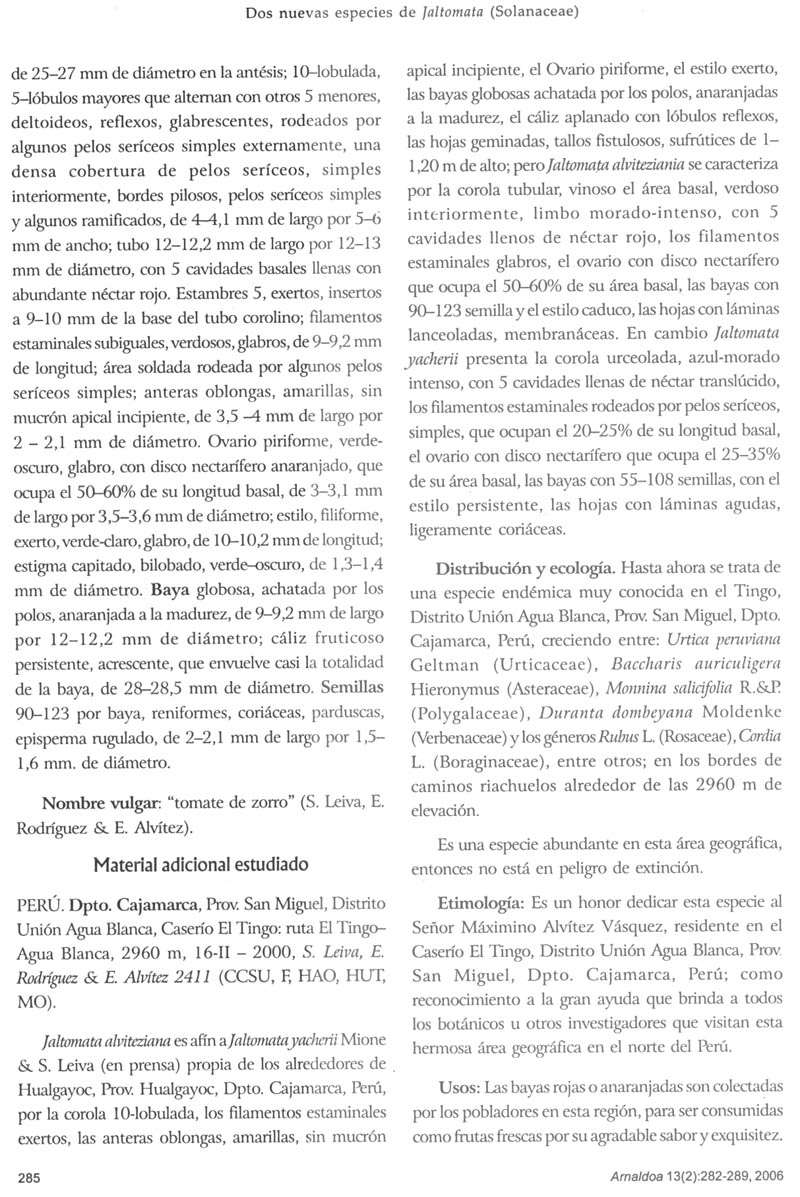Jaltomata alviteziana S. Leiva |
Peru |
revised May 2023 |
| Link to Jaltomata homepage | The information on this page may be cited as a communication with professor Thomas Mione, Central Connecticut State University, Biology Department, Copernicus Hall, 1615 Stanley Street, New Britain, CT 06050-4010 USA, and Segundo Leiva G., Universidad Privada Antenor Orrego, Av. América Sur 3145, Casilla postal 1075, Trujillo, Peru |
Link to local name(s) |
Link to list of edible Jaltomata species, including this one |
Link to table of Jaltomata species that produce red nectar |
Link to the Jaltomata of Cajamarca, Peru
|
Link to Jaltomata species of northern Peru |
| Figure 1, above. Jaltomata alviteziana. Flower and unripe fruits. The flowers we encountered in May of 2015 all had sterile-looking short stamens; the flowers encountered at the time of the type collection had longer, fertile stamens as shown in the illustration (scroll down to see illustration). Numbered units are cm. Photo by T. Mione in Peru, Mione et al. 845. |
| Figure 2, above. Jaltomata alviteziana. Flower. Photo by T. Mione in Peru, Mione et al. 845. |
| Figure 3, above. Jaltomata alviteziana. Back of flower. Photo by T. Mione in Peru, Mione et al. 845. |
| Department | province | locality | elevation m |
habitat | date |
collector |
|---|---|---|---|---|---|---|
| Cajamarca | San Miguel | Distrito La Unión Agua Blanca, Caserío El Tingo. Ruta El Tingo - Agua Blanca | 2960 | 16 Feb 2000 |
S. Leiva G., E. Rodríguez & E. Alvítez 2412 (Holotype: HAO; Isotypes, collection of T. M., CORD, R, HAO, HUSA, HUT, MO). | |
| Cajamarca | San Miguel | Near Agua Blanca. 07 01.729 S 79 03.596 W |
3085
|
hedgerows | 12 May 2015 |
T. Mione, S. Leiva G. & L. Yacher 845 |
|
||||||
| Figure 4, above. Jaltomata alviteziana. Fruit nearly ripe, and flower. Smallest units are mm. Photo by T. Mione in Peru, Mione et al. 845. |
| Character | Description | Figures on this page |
Habit & Height |
Shrub | |
Branches, young |
||
older |
||
Leaves, blade texture & size |
||
| blade shape including margin | ||
| hairs | ||
| petiole | ||
Inflorescence |
2--3 flowers per inflor | |
peduncle |
||
pedicel |
||
Calyx when flowering, color & size |
||
| shape / position during anthesis | ||
| hairs | ||
| at fruit maturity | ||
Corolla color |
||
| green spots | ||
| purple ring | ||
shape and size |
||
lobes / lobules |
||
hairs
|
||
| yes | ||
| no | ||
Stamen length including anther |
||
| length stamens exserted beyond distal end of corolla (applicable if corolla is tubular or campanulate) | ||
| position of stamens: a) before anthers dehisce, b) after anthers dehisce | ||
| base expanded laterally? | ||
| filaments | ||
| anther color | ||
| anther size | ||
| anther mucronate/mucronulate | ||
| insertion of filament into anther | ||
| anthers of a flower open simultaneously? | ||
| pollen grain size | ||
Gynoecium, stigma |
||
Style |
||
| Ovary & Ovarian Disk | ||
Nectar |
||
| Herkogamy | ||
| Protogyny | ||
Fruit color (at maturity) and size |
||
Seeds per fruit |
64, 77, 144 | Mione et al. 845 |
Seed Size |
||
| Character | Description of Jaltomata alviteziana |
| Figure 5, above. Jaltomata alviteziana. Flower. Photo by T. Mione in Peru, Mione et al. 845. |
| Figure 6, above. Jaltomata alviteziana. Flower. Nectar is red-orange. In contrast, the purple pigmentation is in the corolla. Radial thickenings are light in color, dividing the base of the corolla into five nectar troughs. Camera was focused on bottom of corolla rendering the androecium and gynoecium out of focus. Photo by T. Mione in Peru, Mione et al. 845. |



In June of 2023 Paul R. Wilson wrote:
These observations were made on the first four flowers produced by J. alviteziana (accession 900), spring 2023. All lengths of time are approximate. J. alviteziana appears to be protogynous, with a pistillate phase lasting approximately 1 day (morning>following morning). Staggered anther dehiscence is unclear. I have seen some flowers where the three uppermost anthers (flowers start to open facing the ground but are always horizontal by the time the anthers are visible) are dehisced and the two lowermost ones are not, but all are dehisced by early morning.
All flowers had a white and green corolla the first day, which became blue and green as the day went on. Nectar was absent at the start of the first day but was present by the end of it. All four of these flowers yielded very little, if any, pollen after anther dehiscence. Attempts at self pollination appeared unsuccessful. I do not know how unpollinated flowers last because none of them have fallen off yet, though after about six days some of them are starting to turn brown. I gave one of them pollen from J. calliantha because on the off chance it set fruit, this would confirm that alvitez pollen is the only part of the flower that is currently nonfunctional. This flower did drop the corolla after about four days open but I cannot yet confirm if fruit set was successful. If fruit does set, I will move calliantha elsewhere to prevent it from hybridizing, though I have not seen calliantha ever set any fruit on my porch unless I manually pollinate it so I am somewhat skeptical that accidental hybridization is a risk.
Yesterday, a fifth flower opened with anthers that appeared to be larger than those of the previous four. This flower was still pistillate last night but was hermaphroditic by 6:20 this morning, which is earlier in the day than previous flowers(which were not fully dehisced until approximately 10am, though flower #1 dehisced the day it opened). Unlike the previous flowers, #5 did have a noticeable pollen yield(but still appeared to be low relative to other Jaltomata) and I was able to apply pollen to the stigma. I will see if it sets fruit. The bud appeared to be wider than the other flowers as well, but I took no measurements and cannot confirm this.